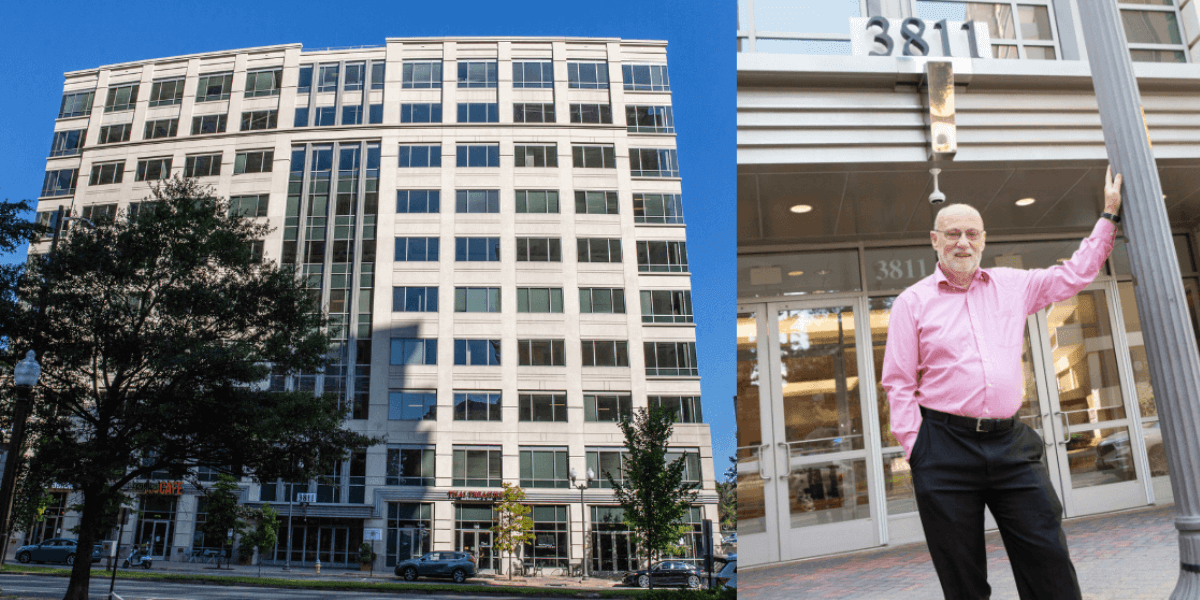
BOB PARKER AT ISI ARLINGTON, SEPTEMBER 2023 / PHOTO CREDIT: JON FISCHER
It was 1997. USC’s Information Sciences Institute (ISI) was an established research center and hub of technological brainpower on the west coast, overlooking the Pacific Ocean. I had just completed an Interagency Personnel Agreement (IPA) at DARPA (Defense Advanced Research Projects Agency), the DoD organization responsible for creating transformational change in support of national security, and was about to return to Marina del Rey. But with historical east coast roots and a desire to raise my family there, I asked a question: could we establish an official east coast presence for ISI?
In 2022 the “Arlington Office” as it is now called – previously known as “ISI-East” – celebrated its 25th anniversary. Located in Arlington, Virginia, near Washington, D.C., it emerged from the consolidation of two existing ISI groups plus a not-yet-formed Advanced Systems Division. ISI-East gradually morphed into a premier research center.
Its proximity to DARPA and other government sponsors positioned the Arlington Office as a hub for applied research, often bridging controlled unclassified work and classified projects, in addition to fundamental research. But before we can talk about what the ISI Arlington Office became, we should understand the focus of the pre-existing component groups and how the Arlington operation changed over time.
It All Began with Tech Support
The earliest east coast ISIers go back to 1989, when DARPA’s Computing Systems Technology Office (CSTO) came to ISI with a simple request. DARPA CSTO wanted specialized IT support for their program managers that incorporated the most advanced technology possible. Familiar with the well-established IT support group in the Marina del Rey location, DARPA, ISI’s principal sponsor, turned to ISI for help.
In response, ISI hired Dan Pederson to put together a team – John Reed, Larry Bookstaver, Brian Miller, and Ray Mason who was the point of contact in Marina del Rey along with Raymond Bates – and they were initially tasked with providing the office fairly routine day-to-day desktop support. However, this role soon expanded as the computing needs evolved. In 1991, DARPA CSTO initiated plans to relocate to Virginia Square, marking the beginning of “scope creep” for ISI-East.
The IT team suddenly found themselves tasked with ensuring DARPA Program Managers arrived at their new offices equipped with cutting-edge hardware – offices set up with multiple monitor NeXT Cube Color systems complete with in-office printer, document scanners, and a generous (for the time) 1GB of local hard disk storage in addition to what was built into the workstations themselves. A much more advanced setup than the rest of DARPA.
Inspired by the U.S.S. Enterprise
With the transition to Virginia Square complete around 1991, the “simple request” became something altogether more complex. Steven Squires, leading the Computing Systems Technology Office (CSTO) at DARPA and an avid Star Trek fan envisioned a High-Performance Computing Enterprise (HPCE) inspired by the U.S.S. Enterprise. He wanted a futuristic environment in which to showcase DARPA technology based on this series; a presentation space as well as a functional lab that could educate government decision makers and the general public on possibilities and capabilities of the internet.
He called it “the country’s access window into the National Information Infrastructure.” It certainly looked the part. Suddenly, the IT support team found themselves at the center of the team that was designing, constructing and provisioning this facility.
“Wouldn’t It Be Neat If…”
The HPCE design was based on the U.S.S. Enterprise control room with similar octagonal design elements, a large projection screen in the front of the room and a raised central seating area where the captain’s chair is located.
It would be a configurable laboratory environment that could accommodate the latest DARPA technology, and include an early cave automatic virtual environment (CAVE) which could create a 3D environment in the room with multiple full wall displays. A team was assembled to bring Squires’ vision to life. This included a Hollywood set designer, a construction supervisor, software developers and CAVE specialists. ISI’s principal role was provisioning the facility with the latest technology and integrating computers, networking, and AV services within the facility, as well as trying to accommodate Steve Squires’ “wouldn’t it be neat if ” requests.
Hat tip to: Bruce Gibeson, Steve Grinovich, Dave Strout, Richard Ogata, Roger Wuerfel, Michael Kelly, Brian Miller, John Reed, and Dan Pederson who were all key parts of this “Enterprise” group. Having this impressive facility on site meant a number of DARPA programs wanted their research systems integrated into the environment for demonstration to defense programs. Those were crazy days, as ISI-East found itself at the forefront of showcasing DARPA’s technological prowess in a captivating and futuristic setting.
The White House Years
The Clinton administration brought a new dimension to ISI- East’s endeavors. Al Gore’s push to bring Internet technology to the White House positioned ISI as a key player and the ISI IT team became frequent White House visitors.
Amidst the White House activities, the team experienced many memorable moments: from Secret Service canines reacting to latent scents in an ISIer’s Jeep left by their dog, to playful interactions with Socks, the White House cat. These episodes added a touch of humor to ISI-East’s impactful contributions to the intersection of technology and government.
Two members of the ISI-East team – John Reed and Brian Miller – installed the technology for a wireless demonstration to PotUS/VPotUS of Multicast backbone (Mbone) video conferencing on the South Lawn of the White House. The demo showcased a world record 4mb Internet connection to the South Lawn using a microwave link. Looking for a location to place the transmitter antenna, Reed was evaluating the rooftop of the Press Club to see if there was a clear line of sight for the microwave link, often called a “clear shot.” Poor choice of words on his part. John suddenly found himself surrounded by secret service agents! Meanwhile, Miller was on the South Lawn along with folks from Motorola working on the microwave link. He remembers the Motorola team had radios tuned into the Secret Service channels and they picked up some chatter about persons pointing “a long skinny cylindrical object from a nearby rooftop in the direction of where PotUS/VPotUS were going to be in a few hours.”
It all got cleared up and the demonstration went on without a glitch, but it highlights the challenges and excitement of bringing cutting-edge technology to the highest levels of government.
Transition to a Full-Fledged Research Group
In February 1994, the growing ISI team established an official office at 4350 North Fairfax Drive, Arlington, VA, although they spent most of their time on site at DARPA. Forrest Houston – who is still at the Arlington Office today – joined the group supporting the HPCE. Around this time ISI-East began a gradual transformation into a research group.
In 1995, Allison Mankin was brought onboard from the Naval Research Laboratory in an effort to bolster the research side of things. Her group worked out of the same building as the ISI IT team, but in different offices. Mankin had been working with ISI researcher Steve Casner and helped create Mbone – which allowed for the streaming of voice and video over the internet to hundreds or thousands of people at once, and was the centerpiece of the demonstrations to PotUS. Her contributions extended beyond Mbone, as she brought a DARPA grant to ISI aimed to build a new testbed, CAIRN, that would provide a wideband ATM backbone and local access at varied speeds.
In 1996, it hosted a community multicast for the IP Next Generation discussion, involving over 500 participants from 40 nations. Additionally, in 1996, Mankin received an NSF grant called TRAIL that enhanced the testbed and was concerned with the scaling and routing designs for IPv6 as it neared operational adoption.
Ushering in the Next Chapter
The transition to a full-fledged research organization was gaining momentum. So, in January 1997, when I returned to ISI from an IPA as deputy director of the DARPA ITO (Information Technology Office), the two groups working out of 4350 North Fairfax Drive combined to form ISI-East and I became the first director of ISI-East and a deputy director of ISI, steering the institute into a new era. By 1997, changes in DARPA contractor rules meant a shift in ISI’s focus. New rules restricted organizations involved in DARPA support work from competing on research contracts.
ISI chose to withdraw from support work to concentrate on its primary mission of research. As ISI phased out support activities, the IT support group diminished, and Forrest Houston assumed the role of in-house IT support and security officer for ISI-East. January 1997 marked a pivotal moment for ISI-East: I found myself standing in a suite of empty, newly leased offices, wondering how to rapidly build a computing research group from scratch. What I needed was staff and money; that would be the next phase of ISI-East’s evolution. The challenges were significant, but the foundation laid by ISI-East’s early years provided the impetus for the next chapter in the institute’s history.
Today, the primary research areas worked on at the Arlington Office are microelectronics and heterogeneous architectures, cybersecurity and testbeds, and artificial intelligence. A multi-divisional research platform that supports a wide range of research, the Arlington Office continues to shape the intersection of technology and government and remains committed to pushing the boundaries of what is possible in the realm of technology and research. It’s come a long way from that “simple request.”
I’d like to acknowledge and thank the contributors to this article who helped piece together this story: Raymond Bates, Larry Bookstaver, Bruce Gibeson, Forrest Houston, Allison Mankin, Brian Miller, John Reed.
Published on June 3rd, 2024
Last updated on June 3rd, 2024













